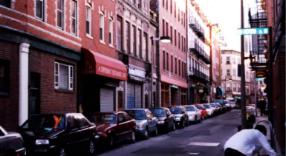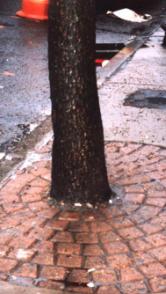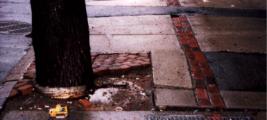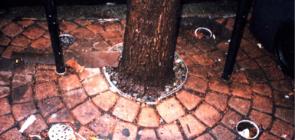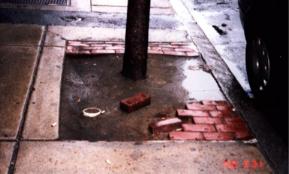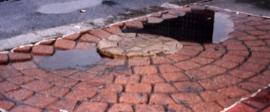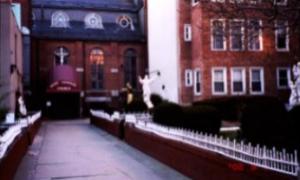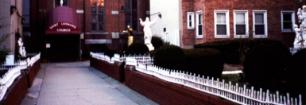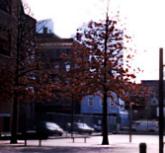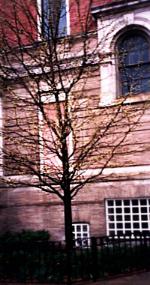Salem Street: A Natural Wasteland
There is not a single tree on the four blocks of Salem Street that I am examining.
There is a stark contrast between Hanover and Salem in not only the building use but also the occurrence of all things natural. The section of Salem St. that I am examining does not contain a single tree. For four blocks, you can walk down the main street without encountering a plant taller than your knee, save those that you can glance down alleyways in small parks. This is most likely due to the nature of the street. It is a one-way street with only enough room for cars to park on one side of the street. The sidewalks are also extremely narrow, even for the city. They allow room for only one person to walk comfortably, and where there is a light post, one must maneuver between it and the building or step into the street. The sidewalks are also solid concrete; they do not even support weeds or moss in the cracks. Clearly, there is not room, nor nutrients nor soil, to support even the most hearty of trees on these sidewalks.
In addition to the lack of space, Salem also tends to seem very dark, even in the middle of the day. Though most of the buildings do not exceed 5 stories, the fact that the separation between the two sides of the street is so narrow makes it seem like the buildings are always casting shadows. In this sense, the buildings are fulfilling some role of the urban tree: that of shade provider. One half of the street is nearly always shaded from the sun's rays, providing a nearly maintenance-free shade-giver. On this street, given the lack of space, inadequate drainage, and inadequate sunlight, it is no wonder there are not trees. Perhaps another reason why Salem does not have the same "feel" and is not as vibrant as Hanover is due to these same things.
Hanover Street: A Relative Garden of Eden
Hanover St. only fares a little better in regards to all things natural. The street itself is much wider than Salem, permitting two-way traffic, parking on both sides of the street, and adequate sidewalk space. Here, there is even enough room for the occasional tree, spaced approximately 6 trees per block. This small number of trees is not nearly sufficient to provide the benefits described in Anne Whiston Spirn's book, The Granite Garden, such as significant shading, absorption of air pollutants, and decreased energy demands. (Spirn, 183) During the spring , summer, and early fall, they do provide for a more aesthetically pleasing streetscape however.
Many of the harsh realities of plant life are evidenced in the environment for trees on Hanover St. They are provided a plot of land narrower than one concrete sidewalk "tile," which is no more then nine square feet. This hardly provides enough ground for rainwater infiltration for a tree, even if the dirt around the base of the tree weren't packed as hard as the surrounding concrete. In addition, many of the trees are not even planted in the center of the small plot of dirt; instead, they are planted closer to the curb, exposing them to the danger of being hit by a car.
An attempt has been made to further protect and nurture some of the trees by putting bricks around their bases. The bricks encircling the base serve two purposes. First, they protect the ground around the tree from being trampled and completely compacted by pedestrians. They also provide a more porous surface for the water to drain through. However, because of the high traffic and almost non-existent spacing between bricks, it seems to me these bricks serve more decorative than environmental purposes unfortunately.
Two examples of the bricks that encircle the trunks of the trees. The bricks do not allow adequate amounts of water to reach the roots of the tree. In this case, the roots of the tree have outgrown the small plot of land it was given and have begun to create heaving in the sidewalk and bricks.
In some plots, there were attempts to provide more water to the roots by adding four drains to the brick design, so rain could better filter through the surface. The drains I saw were all clogged however, so this strategy doesn't seem to be very effective either. In both cases, the intentions were good. People obviously care enough to try to implement some techniques that would give these trees a better chance of surviving in an urban setting than they normally would, but there hasn't been any maintenance and the methods are thus ineffective.The four drains are clogged with trash and are most likely not facilitating the transport of water to the roots of the trees.
It is also interesting that the trees on one side of the street had significantly broader trunks than the other side, ranging from 8-12 inches in diameter to only 4-6 inches on the other side of the street. I don't really have a concrete explanation involving environmental factors here. Perhaps the soil on one side of the street is richer in nutrients than the other, or maybe the trees on one side were planted a few years after the other. For the most part though, the trees on Hanover St. are a very scrawny and unhealthy looking bunch, though at least there are trees here.
Oddly enough, there isn't any moss, grass, or weeds growing in any of the sidewalks or bricks or even the trampled dirt under the trees. The lack of weeds in the sidewalks is due to the fact that the sidewalks are solid concrete, without even any cracks exposing dirt, as on Salem St. I found it strange that there weren't any weeds under the trees, but the dirt is well trampled from all the pedestrian traffic, so maybe the dirt is so compacted that even weeds cannot survive.
Nothing at all grows in the dirt at the base of the tree, despite the fact that most of the bricks have been removed. No one is even attempting to grow anything in this plot on the corner of Hanover and Cross streets, across from the Central Artery. The area where the tree once stood has been filled in with decorative concrete. A Haven for All Things Green
St. Leonard's Peace Garden provides much needed green space in the North End.
St. Leonard's Peace Garden, further down Hanover St. provides a haven of sorts for plant-life in an area otherwise lacking in green space. The trees lining the fence just inside the garden have much denser branches than those on the sidewalk outside of the street, probably due to the fact that they can benefit from being planted in open ground instead of the small plots of land delineated to the other trees. Inside the gates are two raised plots of land containing many thriving evergreen bushes, grass, and statues. There is a hose and spigot, indicating that this garden must be watered to keep the grass green, but with about three feet of soil in the raised section, there would probably be sufficient space for water storage and drainage. The relative health of these trees and bushes compared to those on the street is similar to that described by Spirn in the case of the Kahn plaza in Philadelphia. (Spirn, 194) Other churches, schools, and libraries in the area could look to this garden as a role model for future gardens they may (and should!) plan.The raised level garden with about 3 feet of soil, much more than on the street, which would account for why these trees and bushes look a lot healthier.
A Shady Place to Play
On one of the smaller streets that connects Salem and Hanover, there is a recreational park/playground that is the width of a block. In this space, there are a number of trees planted in a small brick patio separating the basketball court from another paved play area, as well as around the perimeter of the park behind fences and in a fenced in garden. The trees in the middle of the playground are growing fast for urban trees, having only been planted in 1997. They are much taller than the trees on the street, reaching heights of about 40 feet, though they are still a little skinny. The trees in the garden, even though they are in a large planter, are smaller than those in the brick patio, because schools on both sides shade them, while the trees in the patio are in full sunlight all day long. This is an example of poor planning for the garden; though it may have seemed convenient and space-saving to put the garden between the two schools, the garden cannot thrive or provide the enjoyment it should as much growth because the plants cannot get enough sunlight to grow.
The trees in the brick patio in the playground grow much taller than those on the street and have denser branches. One of the trees in the gated garden; it is smaller than those in the patio because it is in the shade more often. next
